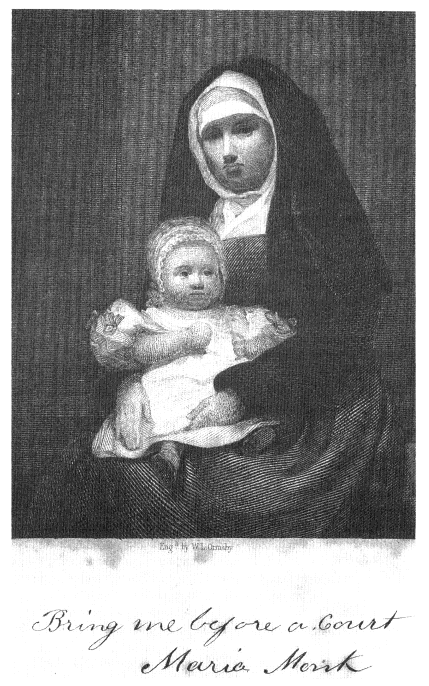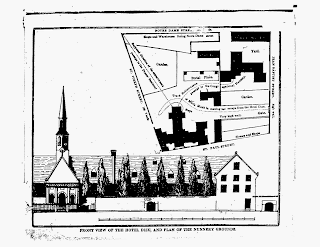Billington, Ray. “Maria Monk and Her Influence.”
The Catholic Historical Review
22.3 (1936): 283-96.
JSTOR. Web. 11 Sept. 2010.
---.
The Protestant Crusade 1800-1860. Chicago: Quadrangle, 1938. Print.
Blair, Jennifer. “Surface Interiorities: Representing the Quebec Convent.”
English Studies in Canada 31.1 (2005): 69-95.
MLA International
Bibliography. Web. 8 Oct. 2010.
---. “The Knowledge of ‘Sex’ and the Lattice of the Confessional.”
Recalling Early Canada: Reading the Political in Literary and Cultural
Production. Ed. Jennifer Blair, Daniel Coleman, Kate Higginson, Lorraine
York. 173-210. Print.
Casteras, Susan. “Virgin Vows: The Early Victorian Artists’ Portrayal of Nuns and
Novices.”
Victorian Studies 24.2 (1981): 157-84.
JSTOR. Web. 21 Sept. 2010.
Derounian-Stodola, Kathryn. “Captivity and the Literary Imagination.”
The
Cambridge Companion to Nineteenth-Century Women’s Writing. Ed. Dale
Bauer and Philip Gould. Cambridge: Cambridge UP, 2001.
Google Books.
Web. 27 Sept. 2010.
Euzenas, Lynn.
Illicit Propriety: Protestants: Sexualized Convent Narratives, and
Pornography in Nineteenth-Century America. Diss. The Claremont Graduate
University, 2006. Proquest Dissertations & Theses. Web. 27
September 2010.
Franchot, Jenny.
Roads to Rome: The Antebellum Protestant Encounter with
Catholicism. Berkeley: U of California P, 1994. Print.
Griffin, Susan. “Awful Disclosures: Women’s Evidence in the Escaped Nun’s Tale.”
PMLA 111.1 (1996): 93-107.
JSTOR. Web. 23 Sept. 2010.
Ingram, Philip. “Protestant Patriarchy and the Catholic Priesthood in Nineteenth
Century England.”
Journal of Social History 24.4 (1991): 783-97.
Academic
Search Premier. Web. 27 Sept. 2010.
Mannard, Joseph. “’Maternity . . . of the Spirit’: Nuns and Domesticity in Antebellum
America.”
U. S. Catholic Historian 5.3/4 (1986): 305-24.
JSTOR. Web. 11
Sept. 2010.
Monk, Maria.
Awful Disclosures, by Maria Monk, of the Hotel Dieu Nunnery of
Montreal, Revised, with an Appendix Containing, Part 1. Reception of the First
Editions. Part II. Sequel of Her Narrative. Part III. Review of the Case: Also, a
Supplement, Giving More Particulars of the Nunnery and Grounds. New York:
Maria Monk, 1836.
Early Canadiana Online. Web. 11 Sept. 2010.
O’Brien, Susan. “Terra Incognita: The Nun in Nineteenth-Century England.”
Past
& Present 121 (1988): 110-40.
JSTOR. Web. 21 Sept. 2010.
Pagliarini, Marie. “The Pure American Woman and the Wicked Catholic Priest: An
Analysis of Anti-Catholic Literature in Antebellum America.”
Religion and
American Culture: A Journal of Interpretation 9.1 (1999): 97-128.
JSTOR.
Web. 11 Sept. 2010.
Schultz, Nancy, ed.
Veil of Fear: Nineteenth-Century Convent Tales by Rebecca Reed
and Maria Monk. Lafayette: Purdue UP, 1999.
NetLibrary. Web. 27 Sept.
2010.
Sullivan, Rebecca.
Visual Habits: Nuns, Feminism, and American Postwar Popular
Culture. Toronto: U of Toronto P, 2005. Print.
Thorn, Jennifer, ed.
Writing British Infanticide: Child-Murder, Gender, and Print,
1722-1859. Newark: U of Delaware P, 2003. Print.





